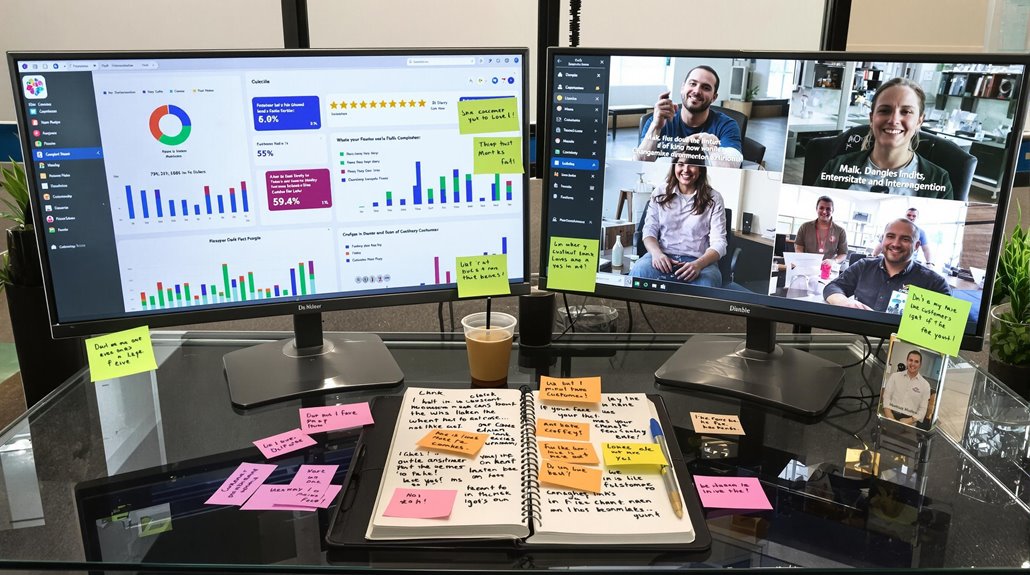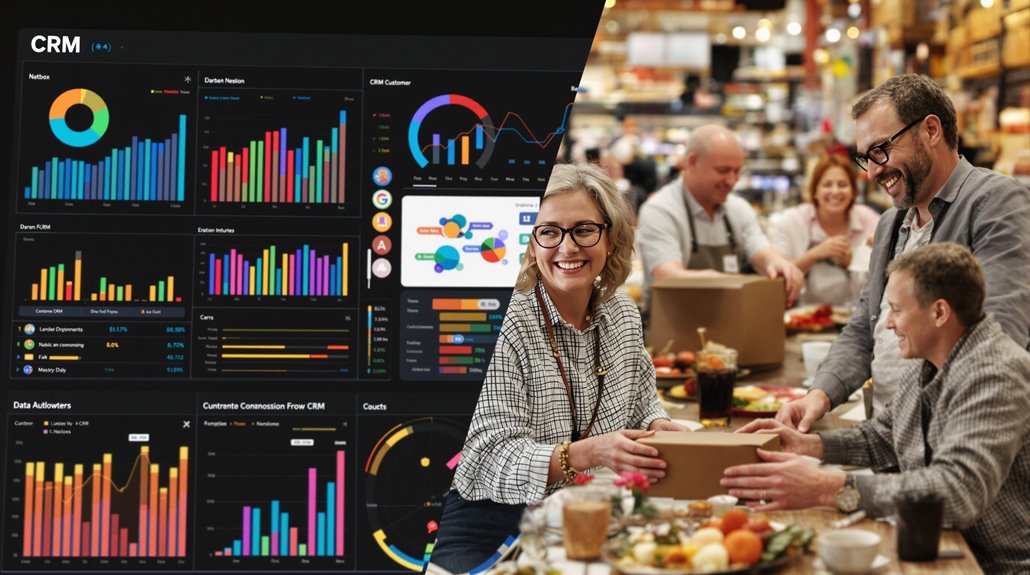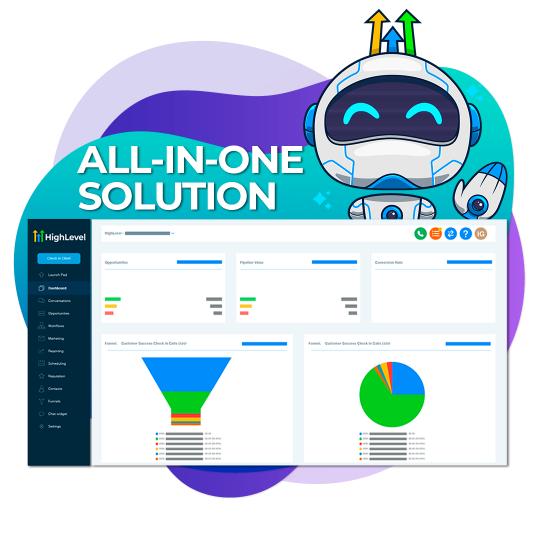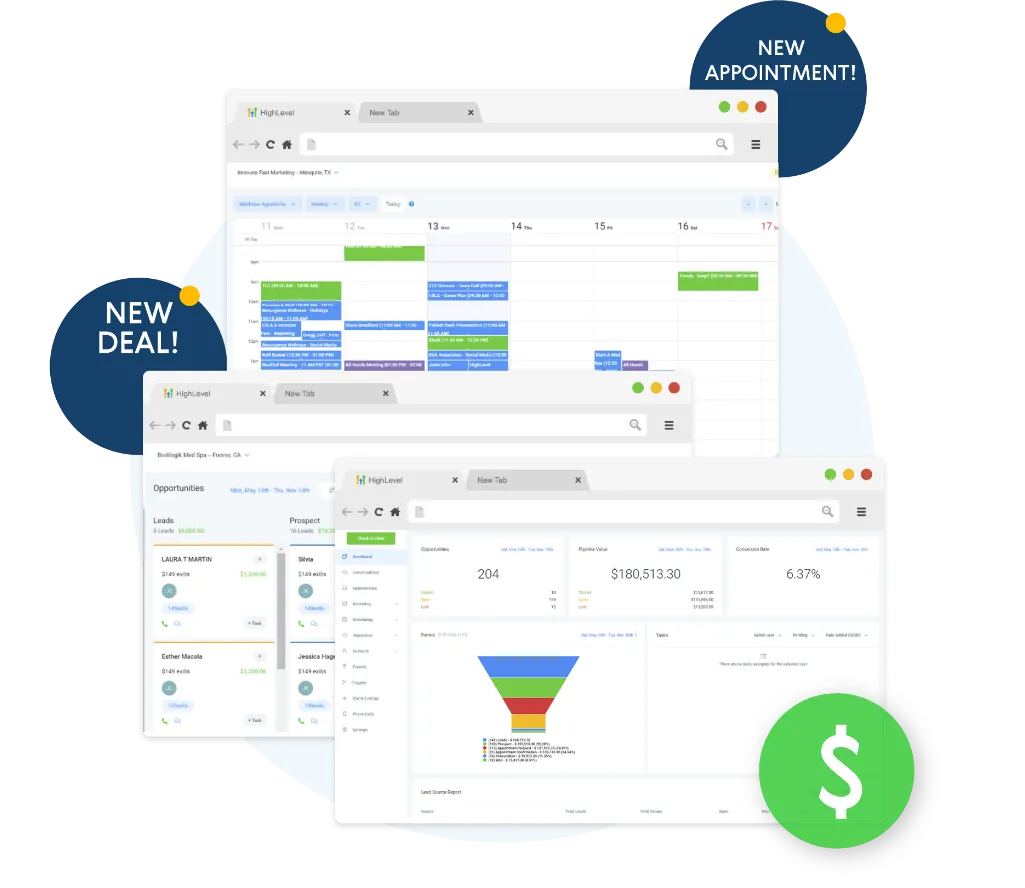Let's paint a picture of your customers' stories. Think of it like putting puzzle pieces together. First, learn who they are and what they like. Listen to what they say and watch what they do. Follow their path as they use your product or service. Keep track of how long they stay with you and how much they buy.
Talk to your customers. Ask them what makes them happy or sad. Write down what they tell you. Look for feelings in their words. When you put all this together, you see the real people behind the numbers.
It's like turning black and white facts into a color movie. Each customer has their own story to tell. By listening and watching, you can share these stories with others.
Feeling overwhelmed by missed leads and disorganized workflows?
Discover the award-winning platform that automates follow-ups, tracks every lead, and keeps your business running smoothly—all in one place. Thousands of businesses are already transforming their sales and marketing with this trusted solution. Don’t miss out—start your 14-day free trial today and click now to uncover exclusive, limited-time special offers!
Understanding CRM Data Fundamentals

Let's talk about the building blocks of customer data. Think of it like making a friend – you learn different things about them over time.
There are four main types of data we keep about customers:
- Who they are
- What they like
- How they feel
- What they do
Just like you save your friends' phone numbers, we keep basic facts about customers. This means their names, where they work, and how to reach them.
When we store this info the right way, it helps us be better friends to our customers. It's like having a neat drawer where you can find everything you need.
This also keeps customer info safe, which is very important.
Mapping the Customer Journey
Let's follow our customers like friends on a special trip. Think of all the ways they meet our brand – from the first hello to coming back as happy customers.
First, we get to know our real customers. We learn what they like and what they need. Then, we look at the steps they take with us. What do they want? What makes them happy?
We talk to customers and look at numbers to see the whole picture. We want to know every time they connect with us.
Some helpful tools like Smaply, TheyDo, and Mapovate show us where customers go. These tools help us fix problems fast and make things better for them.
Ready to simplify your business operations?
Streamline your workflows and boost productivity with a CRM designed to save you time and effort. From tracking leads to automating follow-ups, this platform does it all. Discover what’s possible—learn more about how it works and see why so many businesses rely on it every day.
Key Performance Indicators Matter

We track simple numbers to see how our business grows.
These numbers tell us if customers stay with us and if new people become buyers. We also look at how much money each customer spends with us.
When we look at these numbers, we can see what works best to help people buy from us. This helps us make our service better and grow our business.
Tracking Growth Through Data
Growing your business is like watching a garden grow. You need to keep track of important numbers to see how well you're doing.
Look at how much money you make each month. See how much it costs to get new customers. Count how many customers stay with you and how many leave. These numbers tell you if your business is healthy.
Think about how much each customer spends over time. Also look at how happy they are. When customers are happy, they stay longer and spend more. Ask them what they think and use their answers to make things better.
The more you watch these numbers, the better you can help your business grow strong and tall – just like a well-tended garden.
Conversion Metrics Tell Stories
Numbers tell stories about how well a business is doing. Every time someone buys from you or comes back to shop again, it shows if people like what you do.
When we look at how many visitors turn into customers, it's like watching people walk through your store. Some people just look around. Others buy things and come back for more. These numbers help us see if we're making people happy.
By watching what people do on our website and how they shop, we learn what they like best. We can see which products they love and what makes them want to buy more. This helps us give people more of what they want.
Our numbers also show us how much it costs to get new customers and how much they spend with us. This helps us make smart choices to help more people and grow our business.
Journey Analytics Drive Success
Your customers are people on a journey with your business. When you look beyond basic numbers, you can see their whole story. By mixing simple stats with journey data, you learn how to serve them better.
| Metric Type | What It Shows You |
|---|---|
| Net Revenue Retention | How well you keep money coming in |
| Customer Churn Rate | How many people stop using your service |
| North Star Metric | What makes customers happy |
| Relationship Score | How much customers like you |
| Lifetime Value | How much a customer spends over time |
Still struggling to keep your business organized?
Take the guesswork out of managing leads and follow-ups with a platform trusted by thousands of businesses. Say goodbye to missed opportunities and hello to a seamless sales process. Act now—try it free for 14 days and discover how easy it is to stay on top of your workflow. Don’t wait—exclusive offers won’t last long!
Digital Touchpoint Analysis
We look at how people use our online tools to talk with us. Think of it like watching how friends play together at recess.
We see when they like our posts, open our emails, or visit our website. We also ask them how they feel when they use these tools. This helps us know what makes them happy and what makes them upset.
When we know these things, we can fix what bugs them and do more of what they love. This makes people want to keep coming back to us.
Digital Channel Performance Metrics
We look at numbers to see how people use our online help tools. Think of it like watching where people go when they need help. We count how many people ask for help, when lots of people need help at once, and how fast we can solve their problems.
To learn from these numbers, we gather info from all the places where people talk to us. Smart computer tools help us read what people say and tell if they're happy or sad. We can see this info right away, which helps us give better help.
We also look at what people buy and how they use our website to better know what they want.
Experience Score Deep Dive
We look at how people use your website to understand their feelings. Simple tools help us see what makes people happy or upset when they visit.
We watch how people move around your site, fill out forms, and spend their time. Our smart tools turn these actions into clear pictures of what your visitors like and don't like.
We can spot when pages load too slow or when people get stuck. This helps us fix problems and make your site better.
When we know what bothers people, we can make changes that help them enjoy using your site more.
Converting Metrics Into Stories

Numbers can tell stories about real people who use your products. When you look at things like how long customers stay with you and what they say about you, you start to see their stories.
Look for patterns in what your customers do. If more people stick with you over time, it means you helped fix their problems.
Listen to what people say on social media and in their feedback. This helps you know them better.
When you group customers by how they use your products, you can see what they like and need.
These real stories help your team make better choices to help customers.
Struggling to keep up with your growing business?
Simplify your processes and stay ahead with a CRM that adapts to your needs. Manage leads, automate tasks, and focus on what matters most—growing your business. Take the first step—explore the features today and see how it can transform the way you work.
Building Customer Experience Profiles
We study how real people use our business. We look at things like their age, what they like, and how they shop with us. This helps us know them better.
We watch how they move from one part of our business to another. This shows us what works well and what needs fixing.
When we see how people act, we learn what they want and what bothers them. Then we can make things better for them.
Data-Driven Persona Development
We learn about our customers by looking at lots of data. This helps us make better stories about who they're and what they need.
First, we look at how people use our website and what they say on social media. We also talk to real customers to make sure we got it right.
We then make simple profiles that show:
- What customers do online
- What problems they face
- How they use our products
These profiles need to change as our customers change. We watch how they react to our work and fix our profiles when we learn new things.
This way of working helps us know our customers better than old methods did. It's faster too. When we know our customers well, we can help them better.
Journey Pattern Recognition
Let's look at how your customers move around your brand. Watch how they visit your website, store, and other places. This helps you learn what they like and need.
First, think about what you want to learn. Then, get to know your customers well. Write down how they act and what they want. Make a simple map of all the ways they talk to your brand.
Keep track of what your customers do in a customer database. Look at the data to spot problems. Use what you learn to make things better for them.
The best part? When you know these paths well, you can help customers faster and make them happy.
Behavioral Insight Mapping
Getting to know your customers better means watching how they act when they deal with your brand. You need to look at all the ways they work with you. This helps you learn what they like and don't like.
To understand your customers better:
- Watch how they use your website or store
- Look at how they feel when they buy things
- Put them in groups based on what they want and need
- Find out what makes them happy or upset
- Look for ways to fix problems they have
- Make their time with you feel more personal
The more you learn about your customers, the better you can help them.
Watch what they do, listen to what they say, and use this info to make things better for them.
Data Integration Best Practices

Getting your data to work together is like putting together a big puzzle. First, make a plan and get your team to help. Think about what you want to learn about your customers.
Keep your data clean and correct. Use tools that fix mistakes and get rid of copies. Think about the best way to join your data – you can put it all in one place or let it stay where it is.
Watch how well things work by looking at how many people buy from you and stay with you. Ask people what they think. This helps you make things better and know your customers more.
Journey Mapping Success Strategies
Let's walk through how to tell your customer's story on paper. Think of it like drawing a map of how people feel when they use what you make or do.
Pick one kind of map to start:
- See how things work now
- Plan how you want things to work
- Show all the parts that make it work
Break the story into small steps. At each step, write down:
- What people do
- How they feel
- Where they go for help
Keep it simple. Focus on what matters most to make things better for your users.
Look at how real people use your stuff. Talk to them. Watch what they do. Write down both what they say and how they act.
Make a clear plan:
- Pick who'll fix each problem
- Set goals you can count
- Check if things get better
Remember: A good map helps you see the whole story through your customer's eyes.
Customer Feedback Collection Methods

We need to hear what our customers think. There are many ways to do this. We can ask them to fill out simple forms. We can talk to them in person. We can also see what they say about us online.
When we meet with customers face to face, we learn a lot more than just numbers. We can ask them deep questions and really understand their needs. It's like having a good talk with a friend.
After customers tell us what they think, we must take action. We should let them know what we're doing with their ideas. This shows we care and want to make things better for them.
When we listen and act, customers know they can trust us.
Emotional Intelligence in CRM
Feelings matter when we talk to customers. When we care about how customers feel, they stay with us longer. This helps turn simple numbers into real stories about people.
Think of it like building a bridge between facts and feelings. When we listen and care:
- Our customers are happier
- We make more money
- Our tools help us know how customers feel
When you can spot how a customer feels, you can help them better. This makes them want to come back. It also helps your business grow.
Simple acts like listening and caring turn quick chats into real friendships with customers. The more we show we care, the more our customers trust us.
Remember: happy customers mean a happy business. By paying attention to feelings, we make better connections that last.
Measuring Customer Sentiment

We want to know how our customers feel about us. We use three simple ways to listen to them: looking at their words, asking them questions, and getting quick feedback.
When customers talk to us, we look at their words to see if they're happy or upset. We use smart tools that read what they say and give each comment a score from 1 to 5.
We also send simple surveys to ask how we're doing. These surveys tell us if customers like us and if they'll come back.
When we look at all this info, we can see what we do well and what we need to fix.
From Numbers to Narratives
Stories matter more than just numbers. When we listen to what customers say and watch how they use our help, we learn more about them. This helps us see the real people behind all those numbers.
Think of your best customers. Look at how they grew with you over time. Each step shows a small win that adds up to their success story.
When customers leave, we can learn why. Look at what they said before they left. See how long it took to fix their problems. This helps us do better next time.
We can also plan ahead. By looking at what customers need now, we can get ready to help them later. This keeps them happy and helps them stick with us.
Remember:
- Share customer success stories
- Learn from those who leave
- Get ready to help before they ask
Creating Compelling Case Studies

We turn customer stories into easy-to-read case studies.
First, get real facts from your customers. Find out what their company does. Get numbers that show how you helped them. Ask them to tell you in their own words how things got better.
Start with a short but exciting intro that makes people want to read more.
Then tell the story in three parts:
- What problems the customer had
- How you fixed those problems
- What good things happened after
Put in real numbers to show how well things worked. But don't use too many numbers – just the ones that matter most.
Make your case study look nice with pictures and clean design.
Share it where your future customers will see it. Use tools like HubSpot to help you make and share these stories with more people.
Conclusion
Think of CRM numbers as little clues about real people. Like a cook who turns simple food into tasty meals, we can turn these clues into stories. When we mix facts with what customers tell us, we make stories that matter. Each number shows us how a real person felt or what they did. These stories help us make things better for everyone.








